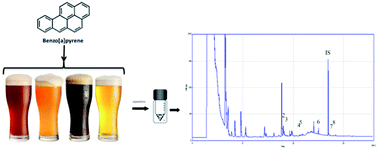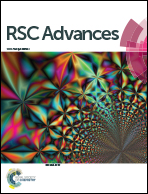Fast analysis of nine PAHs in beer by ultrasound-vortex-assisted dispersive liquid–liquid micro-extraction coupled with gas chromatography-ion trap mass spectrometry†
Abstract
An Ultrasound-Vortex-Assisted Dispersive Liquid–Liquid Micro-Extraction (USVADLLME) procedure coupled with Gas Chromatography-Ion Trap Mass Spectrometry (GC-IT/MS) is proposed for the fast analysis of nine polycyclic aromatic hydrocarbons (fluorene, phenanthrene, anthracene, fluoranthene, pyrene, chrysene, benzo(b)fluoranthene, benzo(a)pyrene and benzoperylene) in beer (alcohol by volume ≤7%). Among 5 possible extraction solvents tested, dichloromethane, density 1.325 g mL−1 at 25 °C, was selected for method development. Parameters such as extraction solvent type and volume, extraction time and pH, and NaCl concentration were optimized. Under optimal conditions, the enrichment factors of the nine analytes range between 100 and 200 fold, the recoveries from 83% to 99% and the correlation coefficients from 0.9982 to 0.9999. The limit of detection (LOD) and limit of quantification (LOQ) are ≥3.8 pg μL−1 and ≥9.8 pg μL−1, respectively. The precision expressed as relative standard deviation (RSD), is ≤4.0%. The whole proposed methodology was demonstrated to be simple, reproducible and sensitive for the determination of trace PAHs in beer samples.


 Please wait while we load your content...
Please wait while we load your content...